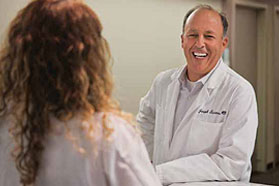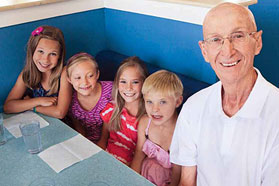A dogged path to a cure
 "I was told then that the disease could be managed for years, but it would eventually kill me. I never accepted that fate."
"I was told then that the disease could be managed for years, but it would eventually kill me. I never accepted that fate."
"I was told then that the disease could be managed for years, but it would eventually kill me," says Plante, who was 64 and living in the East Bay at the time. "I never accepted that fate."
Plante started treatment and retired soon after, moving to the Sacramento area to be closer to his grown children. His doctor recommended that he continue his care at UC Davis. He became a patient of Joseph M. Tuscano, professor of hematology and oncology at the UC Davis Comprehensive Cancer Center and a specialist in the treatment of lymphoma and other blood-borne cancers.
"Cancer treatment must be approached individually and creatively," says Tuscano, who in addition to his clinical practice leads an active research program developing novel approaches to manipulate the immune system to treat cancer. "You always need to be searching for what might work for each patient."
For several years, according to Tuscano, Plante was a textbook patient: He was well for a time, then relapsed, underwent a new treatment, got better again, then relapsed and started a new cycle of treatment.
Then things changed. Plante stopped responding to new therapies. He developed a particularly horrific form of the disease; angry red welts covered his entire body, and what was visible on the skin indicated what was going on within. PET scan images revealed the cancer had spread throughout his body and internal organs.
"After seven different rounds of therapy, Mr. Plante was a ‘hopeless case’ as far as conventional treatment was concerned," Tuscano says. "Fortunately, he was a good candidate for a promising clinical trial."
 "After seven different rounds of therapy, Mr. Plante was a ‘hopeless case’ as far as conventional treatment was concerned. Fortunately, he was a good candidate for a promising clinical trial."
"After seven different rounds of therapy, Mr. Plante was a ‘hopeless case’ as far as conventional treatment was concerned. Fortunately, he was a good candidate for a promising clinical trial."
Tuscano enrolled his patient in a study evaluating the safety and efficacy of a new drug combination: rituximab, a monoclonal antibody that targets and destroys B cells and is a standard treatment for lymphoma, and lenalidomide, a potent immune stimulant that also has many anti-tumor actions. The UC Davis Comprehensive Cancer Center was one of the first centers in the United States to offer this novel combination for non-Hodgkin’s lymphoma.
The trial had phenomenal results. The overall response rate was 80 percent, with complete remission in half the patients. More than half of the patients who got better had, like Plante, stopped responding to rituximab in the past.
"The response was amazing," says Tuscano, "especially considering that this was a population of cancer patients who had ‘flunked’ their other therapies."
Like most of the other participants, Plante’s improvement from combination therapy was dramatic. His skin and internal lesions practically melted away, according to Tuscano. But with that success came an unusual and serious consequence known as tumor lysis syndrome. The lymphoma cells had been destroyed so quickly and in such large numbers that their breakdown products overwhelmed Plante’s body’s ability to eliminate them. His kidneys shut down, and Plante needed careful monitoring and support to pull him through.
Next step — a cure
Although Plante improved far beyond expectations, Tuscano knew the combination therapy was only a stopgap measure. Would Plante, who was always willing to try something new, be willing to undertake one more very drastic experimental treatment that might offer a cure?
A hematopoietic stem cell transplant is the only known therapy that offers a cure for Plante’s lymphoma. But it is considered too toxic for patients over 60. It involves first destroying ("myeloablating") the patient’s immune system with high-dose chemotherapy or radiation, then transplanting a donor’s stem cells to repopulate the bloodstream with normal cells. The procedure is so toxic that up to 40 percent of patients die from the procedure, and only 30 to 40 percent are alive after five years.
Tuscano knew of an exciting clinical trial involving a collaboration of more than 20 medical centers in the United States that offered a new, much less toxic, non-myeloablative approach to hematopoietic stem cell transplantation, in which only low-dose or standard radiation or chemotherapy is used to prepare the body for the transplanted cells. Preliminary results indicated that fewer than 10 percent die from the procedure and that 48 to 75 percent of patients are still alive three years after transplant. The trial enrolled patients up to 75 years old, so Plante qualified.
 Plante is back to a normal life, appreciating every day of it. He takes great pleasure from treating his grandchildren to ice cream, taking daily walks and enjoying time with his wife of 56 years.
Plante is back to a normal life, appreciating every day of it. He takes great pleasure from treating his grandchildren to ice cream, taking daily walks and enjoying time with his wife of 56 years.
"I gave him the standard ‘diaper talk’ — you know, the possibility of terrible side effects including diarrhea 10 times a day," says Tuscano. "Most patients are understandably anxious. But he didn’t flinch. He said, ‘Let’s do it.’"
Plante partially attributes his can-do, optimistic personality to his 26-year career in the Air Force, starting in 1954 after high school graduation. During his nearly month-long hospital stay for the stem cell transplant, medical staffers were amazed that he got up every morning, made his hospital bed military style and did not get back in bed until 8:00 each evening. Every day, he walked a two-mile loop in the ward that he had carefully paced out.
A methodical man, Plante also kept statistics on his medical journey. Over the course of his disease, he needed 220 chemotherapy infusions, 58 pints of blood and 38 bags of platelets.
One year later, Plante is a fit 74 years "young" without detectable cancer and is considered cured.
"We are so fortunate to be able to offer our patients promising new therapies that may not be available elsewhere," says Tuscano. "Without them, Plante would not have beaten the odds to be cured of this disease."
Plante is back to a normal life, appreciating every day of it. He takes great pleasure from treating his grandchildren to ice cream, taking daily walks and enjoying time with his wife of 56 years. The father of five sons and a daughter, Plante is enormously grateful to Tuscano, whom he regards as "my sixth son."
"He was willing to try every new treatment with me," he says. "My whole experience at UC Davis has been the best of the best."







